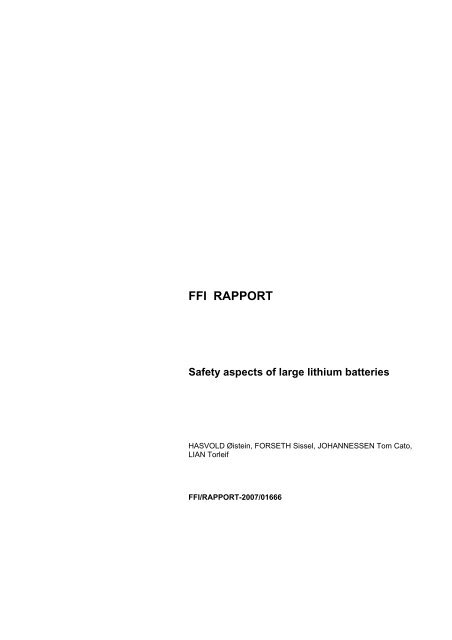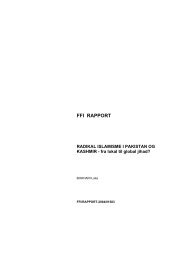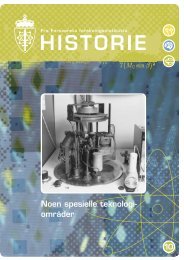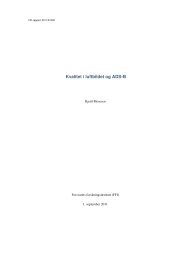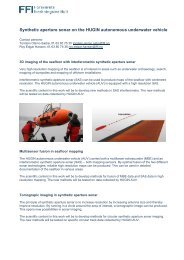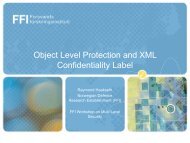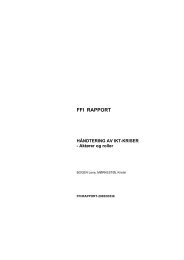ffi rapport - Forsvarets forskningsinstitutt
ffi rapport - Forsvarets forskningsinstitutt
ffi rapport - Forsvarets forskningsinstitutt
You also want an ePaper? Increase the reach of your titles
YUMPU automatically turns print PDFs into web optimized ePapers that Google loves.
FFI RAPPORTSafety aspects of large lithium batteriesHASVOLD Øistein, FORSETH Sissel, JOHANNESSEN Tom Cato,LIAN TorleifFFI/RAPPORT-2007/01666
Safety aspects of large lithium batteriesHASVOLD Øistein, FORSETH Sissel, JOHANNESSENTom Cato, LIAN, TorleifFFI/RAPPORT-2007/01666FORSVARETS FORSKNINGSINSTITUTTNorwegian Defence Research EstablishmentP O Box 25, NO-2027 Kjeller, Norway
3FORSVARETS FORSKNINGSINSTITUTT (FFI)Norwegian Defence Research EstablishmentUNCLASSIFIED_______________________________P O BOX 25SECURITY CLASSIFICATION OF THIS PAGEN0-2027 KJELLER, NORWAY (when data entered)REPORT DOCUMENTATION PAGE1) PUBL/REPORT NUMBER 2) SECURITY CLASSIFICATION 3) NUMBER OFPAGESFFI/RAPPORT-2007/01666UNCLASSIFIED1a) PROJECT REFERENCE 2a) DECLASSIFICATION/DOWNGRADING SCHEDULE 70FFI-IV/328 -4) TITLESafety aspects of large lithium batteries5) NAMES OF AUTHOR(S) IN FULL (surname first)HASVOLD Øistein, FORSETH Sissel, JOHANNESSEN Tom Cato, LIAN, Torleif6) DISTRIBUTION STATEMENTApproved for public release. Distribution unlimited. (Offentlig tilgjengelig)7) INDEXING TERMSIN ENGLISH:IN NORWEGIAN:a) Safety a) Sikkerhetb) Primary lithium batteries b) Primære litium batteriesc) Lithium ion batteries c) Litium ion batterierd) Lithium sulfuryl chloride cells d) Litium sulfuryl klorid cellere) Hydraulic compression e) Hydraulisk trykkTHESAURUS REFERENCE:8) ABSTRACTA battery containing 294 cells in the form of 7 modules of 42 DD lithium / sulfuryl chloride cells in a 7S6Pconfiguration exploded during in-line inspection pigging of a 30” gas pipeline in April 1999. The gas pressure in thepipeline was ca 160 atm. It is likely that the explosion was caused by a leak in the battery container. This reportdescribes the behaviour of the 30 Ah lithium / sulfuryl chloride DD cell (CSC93) under hydrostatic compression (inwater and in inert gas), the effect of state charge and the effect of potting. Potting was found to have a major effect onthe behaviour. The explosion was reproduced when a battery module of 21 cells was exposed to a slow increase inpressure. The explosion occurred at ca 100 atm, as predicted from the compression experiments on single cells.In addition, some experiments with respect to the behaviour of batteries with different battery chemistries under abuseconditions were made. This includes the effect of slow heating, the effect of fire on sealed battery containers, the effectof nail penetration, the effect of water intrusion and the effect of abusive charging.Based on the experimental results, general recommendations on how to improve the safety of the use and storage oflarge lithium batteries have been made.9) DATE AUTHORIZED BY POSITIONThis page only2007-06-22 N J Størkersen Director of ResearchISBN 978-82-464-1198-9UNCLASSIFIEDSECURITY CLASSIFICATION OF THIS PAGE(when data entered)
5CONTENTSPage1 INTRODUCTION 72 SAFETY DEVICES IN LITHIUM CELLS AND BATTERIES 82.1 Cells 92.1.1 Hermetically sealed cells 92.1.2 Poach cells 112.2 Primary Batteries 122.3 Rechargeable (secondary) batteries 122.4 Battery nomenclature 122.5 Battery containers 123 PROJECT PLAN 123.1 External short circuit 133.2 Internal short circuit (nail penetration test) 133.3 External hydrostatic pressure 133.4 Heating of single cells 143.5 Abuse tests of large batteries and battery modules 143.6 Exposure of battery packs to fire 143.7 Exposure of batteries to seawater 144 CELLS, CELL CHEMISTRY AND DESIGN 154.1 Lithium-liquid cathode batteries 164.1.1 CSC93, Li/SO 2 Cl 2 174.1.2 Li/SOCl 2 184.1.3 Li/SO 2 184.2 Lithium / solid cathodes 194.2.1 Li/MnO 2 194.2.2 Lithium ion 194.3 Li-ion polymer 204.4 Test matrix 215 RESULTS 225.1 External short 225.1.1 Lithium sulfuryl chloride, CSC93 cells 225.1.2 Thionyl chloride cells, LSH20 225.1.3 Thionyl chloride cells, low rate bobbin 235.1.4 Lithium manganese dioxide 235.1.5 Lithium sulphur dioxide cells, LO26SX 235.1.6 Lithium ion cells, ICR34600 23
65.1.7 Lithium polymer cell, Electrovaya 12Ah Super Polymer 245.1.8 Lithium polymer – HUGIN 1000 blocks 245.2 Internal short 255.2.1 Lithium sulfuryl chloride, CSC93 cells 255.2.2 Thionyl chloride cells 255.2.3 Lithium manganese dioxide 255.2.4 Lithium sulphur dioxide cells 255.2.5 Lithium ion cells, AGM ICR34600 265.3 External hydrostatic pressure, pressure media H 2 O and N 2 265.3.1 CSC93, Li/SO 2 Cl 2 DD-cells 265.3.2 Full scale test of SO 2 Cl 2 7S3P battery module in a battery containerin a pig-trap 315.4 Heating: 325.4.1 CSC93 DD cells 325.4.2 Heating of battery container with battery 345.4.3 Heating of Li/MnO 2 D-cells 355.4.4 Heating of Li/SO 2 365.4.5 Heating of Li/SOCl 2 375.4.5.1 Spirally wound with safety valve 405.4.6 Lithium ion (AGM ICR 34600) 405.4.7 Lithium polymer 435.5 Summary of the heating experiments 455.6 Charging of a single string of CSC93 cells in a module 466 EFFECT OF SEAWATER INGRESSION IN BATTERYCONTAINERS 496.1 Single cells 496.2 Serially connected cells 496.3 Effect of water under pressure 507 OVER-CHARGING OF LITHIUM ION CELLS 508 DISCUSSION 508.1 CSC cells and batteries 508.2 Batteries and water 518.3 Batteries and fire 519 RECOMMENDATIONS 5310 CONCLUSION 54A TECHNICAL INFORMATION 5511 REFERENCES 69
7Safety aspects of large lithium batteries1 INTRODUCTIONLithium batteries are used in ever increasing amounts because of their superior propertiescompared to more conventional batteries. Typically they exhibit good rate capability and lowself discharge over a large range of temperature. Specific energy densities of more than200 Wh/kg (or five time’s lead acid batteries) are typical for the best rechargeable lithiumbatteries. Primary batteries may contain even more energy; specific energy density of600 Wh/kg is reported for some systems. This is comparable in magnitude to traditionalexplosives and if the energy is not delivered to the user as electric energy, but transferreddirectly to heat in the battery over a short time period, the results might be devastating.The history of lithium batteries is full of examples of explosive fires destroying plants and warehouses and of explosions in equipment using such batteries. As more and more knowledge hasaccumulated however, the frequency of accidents has decreased drastically in spite of anenormous increase in their use, but laptops and mobile phones catching fire is not totallyuncommon – even today.The Norwegian Army was one of the first to introduce lithium batteries (lithium sulphur dioxide(Li/SO 2 ) chemistry) in the late seventies because of their excellent properties, also at lowtemperature. Of cause we got our share of explosions and the Army Battery laboratory burneddown in 1980. After these incidents, FFI has been more or less continuously involved withsafety related work on lithium batteries (Vaaland and Eriksen1982, Hasvold et al 1984,Størkersen et al 1986) and has established an international network within NATO. In addition,FFI participates in The Lithium Battery Technical/Safety Group, a forum for US Governmentagencies. These networks give us access to unpublished results on safety incidents and valuabletest results on battery abuse, fire fighting and damage reduction.At present, FFI is actively working on lithium ion batteries (both polymer and hermeticallysealed) for use in autonomous underwater vehicles (AUV) such as HUGIN 1 and HUGIN 1000,and as power sources for soldier systems (NORMANS project).The major driving force for this specific project was an incident that happened in the Statpipegas pipeline between Heimdal and Draupner. Lithium battery powered pipeline inspection tools(“Pigs”) are used by the oil and gas industry for internal inspection of pipelines. Usually, thebattery is confined within a sealed unit. If this seal develops a defect, an internal rise of pressure
8takes place until the external pressure is approached. A battery containing 294 cells in the formof 7 modules of 42 DD lithium/ sulphuryl chloride cells in a 7S6P configuration explodedduring pigging of a 30” gas pipeline in April 1999. The gas pressure in the pipeline was 16 MPa(160 Bar). Even larger batteries, based on 567 cells, are used in 40” pigs. Similar batteries areused as emergency power in diver habitats.FFI was asked to undertake a project for Statoil ASA and Gassco ASA with the objective ofidentifying the cause of the accident, and to look at ways to improve the safety of the system.Alternative power sources for this application were also of interest. The project started in theautumn of 2003 and was concluded in the spring of 2006. Ahead of this work, the SINTEFstudy “Risk analysis – use of lithium batteries in pipeline pigs” (Report no. STF38 F02403,January 2002) and Det Norske Veritas Report “Risk analysis of lithium Batteries in PipelinePigs” (DNV report no 2002-3217) as well as the Statoil governing document “Transportation,storage and pigging with internal pipeline tools containing Lithium batteries” WR1502, version2.01 Valid from 01.06.2003 were made available to us.The target for this project was to:• Collect available literature on the safety aspects of lithium batteries• Experimentally evaluate conditions that may induce fire or explosion in lithium batteries,specifically:o Determine the effect of hydrostatic pressure on cellso Determine the effect of penetration of water into cells and batteries• Make recommendations on how to handle battery fires• Make recommendations on how to build batteriesBecause some of this work is of general interest to Kongsberg Maritime ASA (KM) and to theNorwegian Defence, part of this work was also financed by KM and by FFI.2 SAFETY DEVICES IN LITHIUM CELLS AND BATTERIESIn addition to the selection of the best high quality chemicals and components in order to makethe cells as safe as possible, responsible manufacturers of lithium cells and batteries invariablyequipped them with a number of safety devices to protect the cells against abusive conditionssuch as short circuit, unintentional charge, overcharge and over-discharge and voltage reversal.One also tries to reduce the damage in case of exposure to external heating. However it shouldbe understood that, as cells contain both fuel (lithium) and an oxidant (the cathode material)within a single container, a high energy cell that is “safe” under all conditions of abuse is not apossible option. Some cell chemistries also use an organic electrolyte. In presence of oxygen(air), burning electrolyte may contribute to the energy released by a battery fire.Some of the more common safety devices will be described in the following:
92.1 Cells2.1.1 Hermetically sealed cellsThe content of the cell can is contained within a metal container, commonly (but not always)connected to the negative electrode (anode). The contact to the positive electrode (the cathode)is via a glass to metal seal welded into the can. The can contains the anode or “fuel” (lithium, alithium alloy or lithium intercalated into carbon or some other host lattice in lithium ion cells);an electrolyte (a liquid into which a lithium salt has been dissolved) and an oxidant. In addition,the cell contains a separator between the positive and negative electrode and current collectorsto the electrodes. If the electrolyte liquid is also the oxidant, (e.g. sulphur dioxide, thionylchloride or sulfuryl chloride), the term catholyte is often used. In solid cathode chemistries, (e.g.manganese dioxide and lithium ion cells) the electrolyte is made from a mixture of organicliquids with a flammability very similar to gasoline.The cell also contains a void volume in order to tolerate expansion of the materials in the cell.When the cell is heated, an increase in the vapour pressure of the electrolyte takes place.Whether this heating is external, is caused by the current flowing in the cell or is caused by anexothermal reaction taking place in the cell, the result is an increase in pressure. At sometemperature, the vapour pressure of the electrolyte will cause the cell can to burst open.One consequence of this void volume is that if the cell is exposed to an external hydrostaticpressure exceeding a certain value it must collapse.Figure 2.1 shows an example of a high rate, spirally wound cell design and figure 2.2 a low-ratedesign (bobbin cell). The spirally wound cell has very much lower internal resistance, resultingin very high current capability, but the larger amount of inert materials such as separators andcurrent collectors also results in lower capacity at very low rate compared with the bobbin cell.
10Figure 2.1High rate, spirally wound cell showing the design. The jelly roll in this D-cell is1.8m long unwound, giving a large electrode surface area within a small cell.(Courtesy of AGM)Figure 2.2Lithium thionyl chloride low rate cell (bobbin design). The cathode is made fromhighly porous carbon powder and a binder. Courtesy of Sonnenschein GmbH.
11Safety valveMost manufacturers equip the cells with a weak spot, a safety valve, that allows the cell to burstopen at a temperature well below the melting temperature of lithium (180ºC) and most also at atemperature well below the mechanical breakdown temperature of the separator between theelectrodes. For cells with a liquid cathode, the composition of the electrolyte changes with stateof charge (SOC), making the opening temperature of the safety valve a function of SOC. Notealso that sulphur dioxide (boiling point -10ºC) is under a pressure of ca 3-4 atm at roomtemperature whereas the boiling point of most other electrolytes are in the 80 to 120ºC range.FuseSome manufacturers equip their cells with a melting fuse. If the current exceeds a certain value,the fuse opens (and the cell stays open circuit). One producer (SAFT) has refined that so that ifthe cell pressure exceeds a certain level, the bulging of the cell top also breaks the circuit.In rechargeable cells, it is more common to use a positive temperature coe<strong>ffi</strong>cient resistor fuse(PTC). If the load is removed and the temperature allowed to fall su<strong>ffi</strong>ciently, the fusereconnects.Shut-down separatorThis separator is a sandwich of different porous polymers. If the temperature exceeds a certainlimit, the polymer with the lowest melting point melts and fills the pores of the high meltingpoint polymer. The result is an increase in the internal resistance of the cell reducing the shortcircuit current. The cell is no longer operational as the change to the separator is permanent.Shunt diodeIf one cell in a cell string has lower capacity then the other cells, it will be driven into reversal atthe end of discharge. The purpose of the diode is to limit the reverse voltage during conditionsof over-discharge to a safe value. It may be built into the cell or added as part of the batteryprotection circuit.2.1.2 Poach cellsPoach cells do not have a metal can, the cell contents are confined within a plastic poach, similarto vacuum packed coffee grains. If an internal pressure develops, the poach “balloons” andbreaks, making the explosion hazard negligible. A fire may develop however. Because they donot contain a void volume, their operations is not affected by external pressure, making them thefavourite candidate for deep-sea autonomous underwater vehicles (AUV) batteries.With the exception of safety valves, poach cells and hermetic cells and batteries have similarprotection devices. Poach cells typically get their mechanical rigidity from the solid electrolyte,typically a polymer into which a liquid electrolyte is absorbed, forming a gel. In addition,binders in the electrodes such as PVDF contribute to the stiffness of the cell.Most polymer cells also depend on the external pressure for stiffness to some extent. Duringproduction, they are evacuated (very similar to vacuum bagged coffee). Poach cells are usedcommercially in lithium manganese dioxide primary batteries and in lithium ion polymerbatteries. It is expected that more cell chemistries with solid cathodes will be available
12commercially as poach cells due to reduced weight and cost of production. Figure 4.2 shows alithium ion polymer cell.2.2 Primary BatteriesGood design practice for making primary lithium batteries is to connect the cells serially intostrings and then connect the strings in parallel via serial diodes. Each string should also beprotected by a fuse. An over-temperature device (thermo switch) is nearly always used in highrate batteries. Battery monitoring circuits are rare but their use is increasing, allowing the userfull control over state of charge and state of health of the battery. In batteries with parallelstrings, equal sharing of the current between the strings is essential and requires use of similarcells in the strings unless each string has the capability of taking the full load.2.3 Rechargeable (secondary) batteriesTypically each cell is equipped with a fuse and the fused cells connected in parallel. Theseparallel assemblies are then serially connected. Because lithium ion batteries are very sensitiveto over-charge and over-discharge, battery monitoring and control circuits are invariably used.As most batteries catch fire on overcharge, dual and independent protection circuits that work onthe cell level are usually used.2.4 Battery nomenclatureA battery composed of 4 serially connected cells is a 4S battery and a battery composed of 3parallel connected cells is a 3P battery. Thus a 7S3P battery is composed of. 3 parallel strings,each string consisting of 7 serially connected cells.2.5 Battery containersBattery containers shall either be vented or be equipped with a safety device that opens in acontrolled manner before the container fragments.3 PROJECT PLANA pre-project with the aim of defining the experimental approach and to develop equipment wasundertaken in the Autumn of 2003, (Prosjektplan for oppdrag 328001, Sikkerhetsaspekter vedstore litiumbatterier i undervannsystemer) the project was concluded in the Summer of 2006.Main focus of the project was the effect on external pressure on the behaviour of cells andbatteries. The cell involved in this incident was the lithium sulfuryl chloride cell CSC93 (DDsize) from Electrochem Industries, Wilson Greatbatch Inc and most work has been concentratedon this cell.
13Increasing the external pressure has the following consequences on a lithium cell:• The opening temperature of the safety valve increases• At some pressure the cell-can may collapse resulting in an internal short• The cell might develop a leak (equilibrating the pressure)If the compressing medium is not inert (e.g. natural gas, nitrogen) but (sea-) water, otherreactions may take place• Traces of water inside the cell destroy the solid electrolyte interface, SEI, betweenlithium metal and the electrolyte.• Hydrogen, chlorine and oxygen might be formed in the battery compartment due toelectrolysis of water.• If the battery compartment fills with water, the heat capacity and the heat conductivity ofthe system increases, reducing the maximum attainable temperature for the system.Main safety concerns by users of these batteries are gas or water leaking into the batterycontainer during operation, and exposure of the battery containers to fire during transport andstorage. This was then reflected in the plan for the experiments.The plan described 6 different test series. Detailed descriptions of the apparatus and the resultshave been published in a series of separate notes. In this report, only a few selected results and asummary will be given. The experiments were:3.1 External short circuitTest 1: The cell was either at room temperature or preheated to its maximum operationtemperature. The short was made with the aid of an electronic circuit composed of 5 parallelMOSFETs with an internal resistance of ca 0.007 ohm. Cell current was measured with a 60 mV/ 100A shunt and cell current and cell wall temperature logged. Cell current was also logged ona high-speed digital oscilloscope. Some experiments were also taped on video.3.2 Internal short circuit (nail penetration test)Test 2: A nail (ø= 3.6 mm and length 95 mm) was driven through the cell and into a woodenbase by a falling weight. Cell voltage and temperature were logged and the experiment taped onvideo3.3 External hydrostatic pressureTest 3: The cells were compressed in a container with 50 mm internal diameter and a volume of360 ml and a safe pressure rating of 120 MPa. Figure 5.8 shows the tank after a cell explosion.The pressure container was either connected to a Shimadzu High Pressure LiquidChromatography (HPLC) pump using deionised water or to a bottle of compressed nitrogen (15to 20 MPa). Stainless steel tubing of 0.3 mm internal diameter was used between the pump orthe gas bottle and the pressure vessel. The HPLC pump switched off automatically at 40 MPa.Weak bolts were used so that a pressure in excess of 60 MPa stretched the bolts, allowing the O-
14ring in the lid to open as a safety valve. Some cells were potted in silicone rubber (ElastosilRT607 (Wacker)) ahead of pressurization.Pressure, temperature and cell voltage were logged at 5 Hz, in later experiments also at 96 kHzduring rapid change of values. In some experiments, the cells were discharged during the testwith 3ohm. At least 3 parallel experiments were made.CSC93 cells at 50 % SOC (State of Charge) were produced from fresh cells discharged for 15hours at 1.00A ahead of the experiments. Cells at 0 % SOC were discharged to 2.50 V at 1.00 A.(See FFI/NOTAT-2006/02782 for details)3.4 Heating of single cellsTest 4: Cylindrical cells were inserted into an aluminium block and heated at 4ºC per minuteuntil 250ºC or until a destructive event took place. FFI/NOTAT-2006/02358 describes theexperiments and the results in details.3.5 Abuse tests of large batteries and battery modulesAbusive experiments were performed on battery packs confined in strong battery containerssimulating either transponders or pig batteries exposed to fire. Due to the large energy in thebatteries, worst case scenarios required larger safety radius than possible at the facilities at FFI.They were therefore undertaken at the Hjerkinn shooting range. The results are described inFFI/NOTAT-2006/02356.3.6 Exposure of battery packs to fireTest 5: Battery packs composed of 48 D-cells (thionyl chloride) were put into a stainless steeltube, open in one end and closed in the other and heated by a propane torch. (See FFI/NOTAT-2006/02356 for details).3.7 Exposure of batteries to seawaterTest 6: Battery packs were confined into two sealed containers with enough seawater to coverthe battery. Pressure, cell voltage and temperature were monitored and recorded. (SeeFF/NOTAT-2006/02356 for details).
154 CELLS, CELL CHEMISTRY AND DESIGNBased on the applications, a list of cell chemistries of interest for evaluation was made. Table4.1 gives a summary.Cell chemistry/designationCell voltageand capacityLi/SO 2 Cl 2 OCV 3.9 V/CSC9330 AhLi/SOCl 2 OCV 3.6V /SL78016.5 AhLi/SOCl 2 OCV 3.6V /LS33600 16.5 AhLi/SOCl 2 OCV 3.6 V /LSH2013.0 AhLi/SO 2OCV 3.0 V/LO26SX 7.5 AhLi/MnO 2 OCV 3.0 V/U3360H 11 AhLi-ionnom 3.6 V /ICR34600 5.2 AhLi-ion polymer nom 3.8 V/36.4 AhSize Weight /g ProducerDD 213 Electrochem IndustriesWilson GreatbatchD 92 SonnenscheinD 90 SAFTD 100 SAFTD/ 85 SAFT(Hawker)D/ 117 UltralifeD 138 AGM“brick” 1623 Ultralife/FFITable 4.1 List of evaluated cells. Cell voltage is either OCV = open circuit voltage or nom= nominal voltage, average voltage during discharge .Inorganic electrolytes (catholytes) consist of a lithium salt (typically ca 1M Lithium aluminiumchloride or lithium bromide) dissolved in the oxidant. These liquids are reduced during thedischarge of the cell.Organic electrolytes, generally used in lithium ion and lithium solid cathode primaries (i.e.MnO 2 ) are considered inert and do not normally take part in the cell reaction. They mayhowever react with lithium. Salts such as lithium carbonate play an important role in thedevelopment of the passivation layer on the anode in lithium primary cells as well as in lithiumion cells. Under abuse conditions (elevated temperatures), reduction of the organic electrolytemay take place at the anode or the electrolyte might be oxidized at the cathode. The salts mostcommonly used are lithium perchlorate (LiClO 4 ) for manganese dioxide cells and lithium hexaflurophosphate(LiPF 6 ) in lithium ion cells. Lithium perchlorate might oxidize cell componentsunder abuse conditions and decomposition of lithium hexa-flurophosphate might give hydrogenfluoride, a poisonous and corrosive gas.
16The physical data for some of the pure solvents and oxidants are shown i table 4.2:(FW = Formula weight, Mp= melting point, Bp = boiling point, Fp = Flash point, d = density)Name Formula Molweightg/molMeltingpoint °CBoilingpoint °CFlashpoint°CSulfuryl chloride SO 2 Cl 2 134.96 -54.1 69.1 -------- 1.667Density g/mlChlorine Cl 2 70.91 -101.6 -34.6 -------- 1.41 (liq,16 bar, 20°C)Thionyl chloride SOCl 2 118.07 -104.5 76 -------- 1.638Sulphur dioxide *) SO 2 64.04 -72.7 -10 -------- 1.434 (liq.)Acetonitrile CH 3 CN 41.05 -48 80-82 5 0.786Ethylene carbonate C 2 H 4 CO 3 88.06 35-37 244-245 160 1.320(EC)Propylene carbonate C 3 H 6 CO 3 102.09 ?? 238-239 132 1.118(PC)1,2-dimethoxyethane C 4 H 10 O 2 90.12 -69 82-85 0 0.8683(DME)Tetrahydrofuran C 4 H 8 O 72.11 -108 66 -17 0.886(THF)*) SO 2 is commonly used together with aceto-nitrile, CH 3 CN, in which case the electrolyte willbe flammableTable 4.2 Catholytes and solvents used in lithium cells. Source: Alfa Aesar 2006-07Research Chemicals Catalogue and WikipediaThese organic compounds have in common a high dielectric constant, making them excellentsolvents for ionic salts. For the same reason, they are all soluble in water and spills should beflushed away with water. The catholytes are very corrosive and forms acids with water. They areeffectively destructed with sodium hydrogen carbonate powder. (NaHCO 3 ). The organicelectrolytes are all flammable, but THF is special in having a low flashpoint and in its ability toform peroxides with oxygen.4.1 Lithium-liquid cathode batteriesLithium-liquid cathode batteries comprise a versatile group of high energy density powersources with a variety of military and civilian application. The Li/SO 2 Cl 2 , Li/SOCl 2 and Li/SO 2are such batteries. In these batteries, the electrolyte is composed of a lithium salt dissolved in areducible solvent (e.g. SO 2 , SO 2 Cl 2 , or SOCl 2 ). The electrolyte may also contain a halogen suchas chlorine or bromine. Thus the electrolyte is also the oxidant and the cathode an inert materialsuch as carbon. Because the cathode reaction is the reduction of the solvent, the term catholyteis often used for the electrolyte in the cellThe stability (K M Abraham, 1991) of the lithium-liquid cathode batteries is dependent on theformation of an insoluble, passivating film on the Li anode surface when the Li comes in directcontact with the catholyte. These films are described as solid-electrolyte-interphases, or SEI,
17since they are impermeable to electrolytes and other liquid reactants while transporting Li +across them. The film has a very low conductivity to electrons, thus the direct reaction betweenlithium metal and the catholyte slows down as soon as the film has been formed.The SEI is responsible for the excellent storage properties of most lithium batteries and also forsome of the less positive properties such as voltage delay. The properties of the film are affectedpositively by some proprietary additives in the electrolyte and negatively by impurities such aswater or iron. Because the film is thin, it may crack if lithium melts allowing a direct reactionbetween the catholyte and lithium metal.4.1.1 CSC93, Li/SO 2 Cl 2The Li/SO 2 Cl 2 is spirally wounded, hermetically sealed and with a glass to metal penetrator forthe positive electrode. The anode is lithium metal, welded to a metal strip which is welded to thecan. The electrolyte consists of LiAlCl 4 dissolved in SO 2 Cl 2 and saturated with Cl 2 . The cathodeis carbon with a binder pressed on to an expanded metal current collector.During discharge, chlorine and sulfuryl chloride are reduced under formation of lithium chlorideand sulphur dioxide. (Lazzar et al, 1981, Liang et al, 1981).The overall cell reaction is4 Li + SO 2 Cl 2 + Cl 2 → 4 LiCl + SO 2 (4.1)or2 Li (s) + SO 2 Cl 2 → 2 LiCl(s) + SO 2 ignoring chlorine (4.2)LiAlCl 4 forms a complex with SO 2 ( Razzini et al, 1980), which as a consequence may lead to areduced increase in the internal pressure during discharge as expected from equation 4.1. Inaddition Cl 2 and SO 2 will be consumed due to formation of SO 2 Cl 2 .The dissociation reaction for SO 2 Cl 2 is (Ciesla, 1986)SO 2 Cl 2 = Cl 2 (g) + SO 2 (g) (4.3)When SO 2 Cl 2 is consumed through equation (4.1) or (4.2), the equilibrium reaction (4.3) will bedriven towards formation of SO 2 Cl 2 reducing the available amount of free Cl 2 in the electrolyte.The CSC93 cell and the 3PD0524 battery module were produced by Wilson Greatbatch /Electrochem Industries. The DD cell is 111 mm long and 33.6 mm in diameter. The cell isprotected by an internal fuse and a shunt diode in the lid and a safety valve. Cell weight isca 214 g. Each module contains 21 cells as 3 parallel strings of 7 serially connected cells (7S3Pconfiguration). The module has a serial diode and a fuse in each string and a temperaturebreaker (104ºC) in the negative lead. The cells in the module are potted in an elastomer. Moduleweight was 6.141 kg.
184.1.2 Li/SOCl 2Three types of Li/SOCl 2 cells were used, one with the designation LSH 20 which is a spirallywound high rate cell and two low rate bobbin cells (SL-780 and. LS33600). The cells LS33600and LSH20 were equipped with safety vents, the SL-780 cell was not.The anode (Besenhard, 1999) in the cell is lithium-metal foil and the cathode is made of porouscarbon. Thionyl chloride serves as both the cathode active material and as solvent in theelectrolyte, which is a 1M solution of lithium-tetra-chloro-aluminate (LiAlCl 4 ). The carboncathode serves as a catalytic surface for the reduction of thionyl chloride.The overall cell reaction is given by4Li + + 2SOCl 2 (l) → 4LiCl(s) + S(s) + SO 2 (g) (4.4)Sulphur and SO 2 are soluble in the electrolyte, but sulphur may precipitates in the cathode poresat the end of discharge. LiCl is insoluble and precipitates at the surface of the carbon cathode,forming an insulating layer which terminates the operation of cathode-limited cells. (Fukuda etal, 1983). The distribution of LiCl within the cathode is rate dependent, partly explaining thelow capacity of the bobbin cell at high discharge rate. Complex formation between SO 2 andLiAlCl 4 may reduce the pressure increase during discharge.Transponders typically use batteries composed of 48 D cells and the duration of discharge maybe up to some years.4.1.3 Li/SO 2The Li/SO 2 cell uses lithium as the anode and a porous carbon cathode electrode (Linden &MacDonald, 1980) with sulphur dioxide as the active cathode material. The electrolyte is amixture of sulphur dioxide and an organic solvent, typically acetonitrile, containing dissolvedlithium bromide. The discharge reaction is given below.2Li + + 2SO 2 (g) → Li 2 S 2 O 4 (s) (4.5)As can be seen form equation (4.5), the SO 2 is consumed implying that the cell pressure isreduced during discharge. The discharge is generally terminated (Linden and MacDonald, 1980)by the full use of the available lithium or by the deactivation of carbon electrode due to blockingof the active area by the precipitation of the discharge product.Li/SO 2 has been the preferred battery chemistry for the Norwegian Defence for the last 25 yearand these batteries are used in large quantities in sizes from a few C-cells to large batteries of 10D-cells or more. It has better low temperature properties than the chloro-halide cells, but itsvolumetric energy density is lower at moderate temperatures.
194.2 Lithium / solid cathodes4.2.1 Li/MnO 2The Li/MnO 2 cell has a lithium-metal anode and a MnO 2 cathode (Besenhard, 1999). Theelectrolyte is usually either lithium perchlorate (LiClO 4 ) or lithium trifluoromethanesulfonate(LiCF 3 SO 3 ) dissolved in a mixture of tetrahydrofuran and 1,2-dimethoxyethane (DME) andpropylene carbonate (PC). Different producers use different compositions and this affect boththe safety characteristics and the low-temperature performance of the cell.The MnO 2 used in the cell is anhydrous and have an optimized crystal structure allowing Li +migrate into the crystal lattice. The overall battery reaction istoMnO 2 + Li → MnO 2 - (Li + ) (4.6)4.2.2 Lithium ionIn Li-ion cells the lithium metal anode is replaced with lithium intercalated in carbon. Carbonhas the possibility to reversibly intercalate Li + . The active material (AGM 2003 manual) of thecathode is also a compound that reversible intercalates lithium ions. LiCoO 2 , which has alayered structure, is the most used material. During charging Li + is removed from the positiveelectrode and inserted in to the carbon electrode. The process is reversed on discharge. Whenlithium-ion cells are charged for the first time (or ‘formed’), the lithium ions are transferredfrom the layers of the lithium cobaltite to the carbon material. Thereby the anode is formed.LiCoO 2 + 6C → Li 1-x CoO 2 + Li x C 6 (4.7)Subsequent discharge and charge reaction are then based on the migration of lithium ionsbetween anode and cathode:Discharging →Li 1-x CoO 2 + Li x+y C 6 = Li 1-x+y CoO 2 + Li x C 6 (4.8)← Charging
20Figure 4.1 shows how the Li + ions and electrons migrate during discharge.Figure 4.1 Lithium-ion discharge cycle (Courtesy AGM 2003).A solution of a lithium salt in an organic solvent is used as electrolyte. In AGM cells, a mixtureof ethylene carbonate and ethyl methyl carbonate with addition of lithium hexafluorophosphate(ca 1 M) is used for that purpose. This is a fairly typical composition, used by most producers.4.3 Li-ion polymerLithium polymer batteries have the same common electrochemistry as conventional lithium ionbatteries. The major difference (UBI) is that they contain a highly porous separator, whichconverts to a gel when a minimum amount of electrolyte is added to operate the cell. In addition,the lithium polymer technology commonly uses the flat, stacked plate cell architecture, seeFigure 4.2. Typically the negative electrode is carbon pasted on a copper current collector sheetand the positive electrode a lithium metal oxide (e.g. LiCoO 2 ) pasted on an aluminium sheet.These electrodes are then stacked interlaced with separator membranes and contained in aplastic poach. The current collectors may be copper (-) and aluminium (+) foil strips protrudingfrom the heat sealed pack. In a battery, the poach cells are typically moulded into a polymer inorder to improve the mechanical strength of the assembly.
21Figure 4.2Lithium ion polymer cell with a stacked plate cell architecture (Courtesy of UBI).4.4 Test matrixIn order to characterise the response of cells and battery packs to different malfunctions andabuse conditions, a set of tests were conducted. The type of cells/battery packs intended to usefor each test as well as the tests are presented in Table 4.3Test/celltypeDD-SO 2 Cl 2D-SOCl 2LRD-SOCl 2HRD-MnO 2D-SO 2D-LiIonLiionpolymer1. External 4 , 20, 70 o C 4, 55 o C 4, 55 o C 4, 20, 60 o C RT RT RTshort2. Internal 20, 70 o C RT RT 20 ,60 o C RT RTshort3a. External RT RT RT RT RT RTpress., H 2 O3b. External RTpress., N 24. Heating 250 o C 250 o C 250 o C 250 o C 250 o C 250 o C 250 o C5. Fire in 3 packs 2 + 3 1 packbattery packspacks6. Reactionwith seawater3 cells 3 cellsTable 4.3Cell types and tests that were performed.The data sheets for the different cells are found in Appendix 1.
225 RESULTS5.1 External shortFor a full description of these tests and detailed results, please see FFI/NOTAT-2007/00705.5.1.1 Lithium sulfuryl chloride, CSC93 cellsThe cells were internally fused and the fuse opened after ca 16 msec. During that period, thecurrent was between 25 and 30 A. No increase in temperature was observed.YTRE KORTSLUTNINGLiSulfurylkloridElectrochem CSC 93 DD, celle 00420040419print_06353025Strøm, amp og Temp, ºC20151050-5-10-20 0 20 40 60 80 100Tid, millisekKortslutningsstrømCelletemperaturFigure 5.1CSC93, cell current and cell temperature versus time. The fuse opened after16 msec.5.1.2 Thionyl chloride cells, LSH20These cells are also internally fused. At room temperature, the short circuit current was initially20A, falling to ca 10A. The fuse opened after 147 msec. No temperature increase was observed.Cells where the fuse was removed and by-passed self-heated until they vented as expected. Ofthe three fresh cells tested, none exploded or started to burn.
23YTRE KORTSLUTNINGLiTionylkloridSaft LSH 20, celle 00220040420print_01353025Strøm, amp og Temp, ºC20151050-5-50 0 50 100 150 200Tid, millisekKortslutningsstrømCelletemperaturFigure 5.2External short. LSH 20 cell current and cell temperature versus time. The fuseopened after 147 msec.5.1.3 Thionyl chloride cells, low rate bobbinThe bobbin cells showed a minor short circuit current and a minor temperature increase aboveambient.5.1.4 Lithium manganese dioxide6 cells were tested at room temperature, one cell vented. If preheated to 55°C, 2 cells out of 3vented. The maximum currents observed were ca 50A. For cells shorted at room temperature themaximum cell temperature increase occurred after 13 - 18 hours and was ca 40°C aboveambient.5.1.5 Lithium sulphur dioxide cells, LO26SXOne cell was tested at 4 o C and 3 cells at room temperature. The maximum currents observedwere ca 55 A. The cells vented at ca 50-60 o C, before the maximum temperature was reached.Maximum measured surface temperature was 69 o C.5.1.6 Lithium ion cells, ICR34600Short circuit current >70A at 100% SOC and room temperature. Current collector tabs meltedand burned off. In discharged cells, the current fell rapidly (20 sec) to below 10A.Two later tests at 100% SOC and room temperature show maximum short circuit current valuesof 90A and 80 A. One cell reached a surface temperature of 95 o C and after the test a leak ofelectrolyte was observed under the cell. The other cell shows smoke and a small flame during
24test, and the current collector tab burned off after 179 seconds. Maximum measured surfacetemperature was 74 o C. It was burned marks around the + end, but no leaks were observed.5.1.7 Lithium polymer cell, Electrovaya 12Ah Super PolymerThe cells were without any cell protection devices. The maximum short circuit current was 94Aand 116A for two different cells at 100% SOC. In the first test a white glowing tab (- tab) wasobserved which again ignited a small flame on the thin plastic cover on the tab surface. Theflame burned out after few seconds. In the second test the distance between the contact points onthe cell tabs and the cell were made as short as possible, resulting in the larger current. This timethe glowing tab and small flame ignited the electrolyte as the cell vented, resulting in a violentfire.Partly discharged cell, (as received) gave a maximum temperature increase of 38°C and a peakcurrent of 61A.5.1.8 Lithium polymer – HUGIN 1000 blocksIn these blocks, each parallel cell is connected via Polymer PTC fuses (SRP200 when Ultralifecells are used, STRP420 in blocks made from Electrovaya cells). The fuse opens after a fewseconds and stays open as long as the load is connected and the heat evolved su<strong>ffi</strong>cient to keepthe fuse above its trip temperature. If the load is removed, the fuse cools and closes again.Batterikloss 004 Elektrovaya20040415PRINT_0512035100308025Strøm, amp604020201510Batteritemperatur, ºC05-200-2 0 2 4 6 8 10Tid, sekunderKortslutningsstrømBatteritemperaturFigure 5.3Block current and temperature versus time. 48Ah block made from 4 ElectrovayaSuper polymer cells. The cells are parallel connected via polymer fuses (SRP420).Initial 10 sec.
25Batterikloss 006 Ultralife20040415PRINT_0218035Strøm, amp16014012010080604020030252015105Batteritemperatur, ºC-200-2 0 2 4 6 8 10Tid, sekunderKortslutningsstrømBatteritemperaturFigure 5.4Block current and surface temperature during short circuit of HUGIN 1000 blockbased on 14 UBI cells. The cells are parallel connected via polymer fuses(SRP200).5.2 Internal shortFor a full description of the nail penetration tests, please see FFI/NOTAT-2007/00705. Thetemperature was measured with an external thermo-element, thus the core temperature of thecell must be significantly higher than measured externally.5.2.1 Lithium sulfuryl chloride, CSC93 cellsThree discharged CSC93 cells, three at 50% SOC and three fresh cells were tested. All explodedinstantaneously.5.2.2 Thionyl chloride cellsThree fresh LSH20 cells were tested. They all exploded violently. Low-rate cells did notexplode and the self-heating was minor (ΔT ca 20°C).5.2.3 Lithium manganese dioxideFresh cells were tested. These cells heated to a maximum of 100°C, but no fire or explosionswere observed.5.2.4 Lithium sulphur dioxide cellsFresh cells were tested. The cell temperature increased by ca 50°C, but no fire or explosionswere observed.
265.2.5 Lithium ion cells, AGM ICR346003 cells were tested at 100% SOC, smoke was always observed and in one incident, the cellexploded 111 seconds after the impact. Figure shows the remains of the cell. Cells at 50% SOCalso became very hot. Discharged cells were benign.Figure 5.5Lithium Ion D-cell after nail penetration at 100% SOC and room temperature.The cell exploded after 111seconds with flames.5.3 External hydrostatic pressure, pressure media H 2 O and N 2A detailed description of these tests is given in FFI/NOTAT-2006/02782. The behaviour of theCSC93 cell has also been described in detail in a paper in the Proceedings of the 42 nd PowerSources Conference, pp75-78, (2006).5.3.1 CSC93, Li/SO 2 Cl 2 DD-cellsFigure 5.6 shows the pressure versus time graph for a cell discharged to 2.50 V with 1.00 A(0% SOC). The flow rate of water is 2 ml/minute, gradually expanding the container andcompressing the cell until something breaks at a pressure of ca 8 MPa. Initially the pressurerises non-linearly as the cell is compressed, then something breaks and the pressure increasestops. Subsequently the cell exploded. Note the difference in slope of the curve during theinitial and the final phase of the compression. In the final phase only solid and liquid materialsare present. At 40 MPa the pump is stopped. Figure 5.7 shows the delay between the collapse
27and the explosion. Initially the cell voltage falls gradually from 2.95V to 2.0V, and then the cellexplodes.explosionFinalcompressionphaseInitialcompressionphaseFigure 5.6Discharged cell pressurized with water at a flow of 2 ml/min. Cell voltage/V andpressure/MPa versus time/s.
28Figure 5.7Enlarged part of cell voltage / V and pressure / 10 MPa versus time / seconds.Same experiment as in Figure 5.6.Figure 5.8 shows the pressure vessel after pressurizing a cell at 50% SOC. In this case, thepressure increased above 60 MPa and the hot gases burned their way through the aluminium lidand body, creating a hole of ca 2 cm 2 and completely destroying the pressure vessel.Pressurization of fresh cells did not lead to explosions and the heat evolution was insignificant.After the test, the cells leaked electrolyte from the top (positive terminal) and showed a concavecell bottom. Figure 5.9 shows the pressure versus time curve for a fresh cell.
29Figure 5.8Pressure vessel after pressurizing a cell at 50% SOC with water at a flow of2 ml/min.5040PressMPa10⋅E_Cell302010Figure 5.900 100 200 300 400 500 600 700 800TimePressure/MPa and open circuit cell voltage versus time/s. Fresh cell. Water flow2 ml/min.Discharged cells and cells at 50% SOC exploded, fresh cells did not. Collapse pressure was7.28 MPa with a standard deviation of 0.24 MPa (n=8).
30Subsequently cells at 0, 50 and 100 % SOC were pressurized with nitrogen gas. None of thesecells exploded, but leaked electrolyte after the test. Collapse pressure in these experiments wasdi<strong>ffi</strong>cult to determine and the cell voltage was unaffected.Battery modules used in pigs are completely encapsulated in a rubber-like material. In the nextexperiment the cell was encapsulated in ca 5 mm thick silicone rubber. Figure 5.10 shows thepressure and cell voltage during the test and figure 5.11 the cell after the test.4030PressMPa10⋅E_Cell20100500 1000 1500 2000 2500 3000 3500 4000Figure 5.10 Pressure/MPa and cell voltage versus time/s. Potted cell at 100% SOC, load 3ohm. Water flow 2 ml/min.TimeFigure 5.11 Cell after the experiment in fig 5.5. Left with potting, right after the removal of thepotting.
31Potting of the cell resulted in an increase in the collapse pressure from 7.28 MPa to 10.29 MPawith a standard deviation of 0.7 MPa (n=9). The damage to the cell was also changed. Inaddition to the indentation in the bottom of the cell, the cylinder wall collapsed. Of the threepotted cells at 50% SOC, one exploded immediately at the collapse pressure, one exploded after14.7 hours and one cell did not explode. Of three fresh cells and three completely dischargedcells, none exploded.Figure 5.12 shows the pressure and cell voltage versus time for one potted cell at 50% SOCpressurized in nitrogen.From the high speed recording, the collapse pressure was 10.0 MPa and the peak pressure59.7 MPa. The time between collapse and pressure increase was 46 msec.60PressMPa10E_Cell40200160 180 200 220 240 260 280 300TimeFigure 5.12 Pressure/MPa and cell voltage / 10V versus time/s. 50 % SOC, load 3 ohm.Nitrogen gas. This cell exploded during compression.As an extra bonus, the void volume of cells that do not explode can be determined from thecompression tests with water. The void volume of the CSC93 cell was ca 8.5 cm 3 comparedwith a total internal volume of the cell of ca 87 cm 3 .5.3.2 Full scale test of SO 2 Cl 2 7S3P battery module in a battery container in a pigtrapA battery container with one 7S3P module at 50% SOC and 2 dummy (Delrin) modules ofsimilar volume was slowly filled with nitrogen until the container exploded. The batterycontainer was placed within a 20 inch sealed tube section in order to simulate a pig trap. Thetube section was 5.9 m long and had an internal diameter of 0.47 m. Ahead of the experiment;the pig trap was flushed with nitrogen at atmospheric pressure and subsequently sealed. Theexplosion occurred when the internal pressure reached 108.7 Bar. This is slightly higher thanobserved with the potted cells described in 5.3.1. Post mortem analysis showed that the batterycontainer had been split at a maximum pressure of 192 Bar. The maximum recorded pressure inthe pipe section was 3.0 Bar. Of the 21 cells in the battery, only 4 exploded, completelydestroying the module.
32The experiment is described in detail in [Johannessen, T C, Hasvold Ø, LianT, Forseth S:FFI/NOTAT-2006/02932 “Experimental study of the effect of external pressure on a pig-batteryinside a closed 20” pipeline section”]5.4 Heating:Single cells were heated at 4ºC/min in an aluminium block with a central, cylindrical cavityØ 37.6 mm and 133.5 mm deep. Usually, the temperature ramp was stopped at ca 260ºC. Blocktemperature and cell temperature as well as cell voltage were recorded. The cell temperature wasmeasured on the underside of the cell with a thermocouple, type K, insulated from thealuminium block with mineral wool.5.4.1 CSC93 DD cells3 fresh cells vented at 119, 126 and 141ºC and a slow, calm lithium fire took place from ca250 ºC. In contrast to this well-behaved manner, 2 cells previously discharged to ca 50 % SOCvented with flames at a cell temperature of 159 and 163ºC. The picture below is from the videoand shows the cells. Time between frames is 40 msec. First, the cell vented, subsequently itburned. The noise was similar to a small rocket.
33Li/SO 2 Cl 2 , DD Electrochem, test 4, 050404800.004.50Temperature ( o C)700.00600.00500.00400.00300.00200.00Venting 119 o CCell temperature(C)Oven temperaure (C)Cell voltage(VDC)Fire starts 251 o C4.003.503.002.502.001.501.000.50Cell voltage (VDC)100.000.000.00-0.500 1000 2000 3000 4000 5000 6000 7000 8000time (s)Figure 5.13Heating of a fresh CSC cell. The event was peaceful and the fire barely visible.Figure 5.14 Heating of two partly discharged CSC 93 cells. Time between video-frames is 40ms. Pictures 001 to 023 are from cell test 140504, pictures 24 to 32 cell are fromtest 100504
34An enlarged frame, Picture 012.tif, is shown below:Figure 5.15 Enlarged frame of Picture 012.tif showing violent venting of CSC cell at 50%SOC.5.4.2 Heating of battery container with batteryA battery container with one fresh 7S3P module based on CSC93 cells was heated with apropane torch. Figure 5.16 shows the resulting temperature and pressure in the container as wellas the module voltage versus time.
35Figure 5.16 Fresh 21 cell battery module in battery container. The container is heatedexternally by a propane torch.It is evident from the figure that at least two ventilations occurred (destroying the temperaturesensor), then the container exploded. Rupture pressure was calculated from the strength andnumber of bolts to be at least ca 7 MPa. Post analysis showed that only 4 cells exploded, 5 cellshad vented (developed a leak) and 12 cells were OK, but with compression damage in thebottom of the cell.The explosion split the battery container and both the container lid and some of the cell canswere able to penetrate a 2 mm thick aluminium screen. FFI/NOTAT-2006/02356 gives adetailed description of the experiment.5.4.3 Heating of Li/MnO 2 D-cellsThe fresh cell vented at 158°C and caught fire at 201°C. The fire was fierce with sparks ofburning lithium as shown in the picture below.
36a) b)c) d)Figure5.17 Heating of Li/MnO 2 cell. a) Cell vents. Ca 9 min later flames are observed, (band c). The remains are shown in (d).5.4.4 Heating of Li/SO 2The un-discharged cell vented at 121°C, after that the cell temperature followed the oventemperature. At 50% SOC, a more interesting curve is observed as in this case, the solidproducts of the cell reactions are still within the cell after the cell has vented. The cell vented at121°C, resulting in a small decrease in cell temperature. After that, small exothermal andendothermal excursions are seen in the cell temperature until the cell voltage fell. After that, asmall exotherm occurred after which the temperature followed the oven temperature closely,indicating no further reactions, even after 1 hour at 260°C. The exotherms are too small to haveany impact on safety.
37400350Cell surface temperature ( o C)Oven temperature ( o C)Cell voltage (100V)300250T thermT oven200100E Cell150100500 1000 2000 3000 4000 5000 6000 7000 8000Time(s)Figure 5.18Heating of Li/SO 2 D-cell at 50% state of charge.5.4.5 Heating of Li/SOCl 2Thionyl chloride cells are used in a large number in transponders in both low-rate and mediumrate applications. The low-rate cell SL-780 was not equipped with a safety valve and explodedvery violently and reproducibly when heated above ca 220°C. Figure 5.19 shows the oven withthe cell.
38a) b)c) d)Figure 5.19 Heating of SL-780 Li/SOCl 2 bobbin cell. a – c shows frames from the video, it is40 ms between each frame. Picture d shows remains from the cell after theexplosion.In contrast, the similar LS 33600 low rate cell vented at 174°C and the electrolyte distilled off.No evidence of exothermic reactions was observed. Figure 5.20 shows a typical result.
39400350Cell surface temperature ( o C)Oven temperature ( o C)Cell voltage (100V)300250T thermT oven200100E Cell150100500 1000 2000 3000 4000 5000 6000 7000 8000Figure 5.20 Heating of fully charged LS 33600 Li/SOCl 2 bobbin cell. Cell temperature (red,solid), oven temperature (blue, dotted) and cell voltage X100 (green, dashed)versus time in seconds. The cell vented at 174°C.Time(s)
405.4.5.1 Spirally wound with safety valveThe LSH 20 cell behaved similar to the LS33600 during the initial phase, but caught fire at265°C. The fire was hot, but peaceful. The figure below shows the behaviour of a cell that wasdischarged to 50% SOC. No significant differences between 50% and 100% SOC was observed.500450400Cell surface temperature ( o C)Oven temperature ( o C)Cell voltage (100V)350T thermT oven300250100E Cell20015010050Figure 5.210 1000 2000 3000 4000 5000 6000 7000 8000 9000 1 . 10 4 1.1 . 10 4Time(s)Heating of spirally wound Li/SOCl 2 LSH20 at 50% SOC.5.4.6 Lithium ion (AGM ICR 34600)The behaviour of this cell at 100% SOC was very similar to the Li/MnO 2 cell. The fire wasfierce. Figure 5.22 shows frames from the video:
41a) b)c) d)Figure 5.22 Heating of AGM ICR 34600 lithium ion cell. a) Cell venting at 165°C, b), c) andd) fume, then fire at ca 198°C.The cell in figure 5.22 vented at 165 and started to burn at 198°C. Data from a different cell isshown below in figure 5.23. This cell vented at 147°C and the fire started at a cell temperatureof 176°C.
42D Li-ion, AGM, test 4, 060404500.004.50450.004.00400.003.50Cell temperature(C)Temperature ( o C)350.00300.00250.00200.00Oven temperature(C)Cell voltage(VDC)Fire starts 176 o C3.002.502.001.50Cell voltage (VDC)150.001.00Venting 147 o C100.000.5050.000.000.00-0.500 1000 2000 3000 4000 5000time (s)Figure 5.23 Heating of fully charged AGM ICR 34600 Lithium ion cell.In contrast, an AGM cell that was discharged to 3.0 V (fully discharged), showed no dangerousbehaviour at all. A small exothermal reaction inside the cell is observed between 150 and 250°Chowever. The figure 5.24 below shows the results.
43400350Cell surface temperature ( o C)Oven temperature ( o C)Cell voltage (100V)300250T thermT oven200100E Cell15010050Figure 5.240 1000 2000 3000 4000 5000 6000 7000 8000 9000Time(s)Heating of AGM 33400 Lithium Ion D-cell discharged to 3.0V (≈ 0% SOC).5.4.7 Lithium polymerA fully charged, pressure tolerant lithium ion polymer battery composed of 14 polymer cellsmoulded into a bloc with polyurethane was heated in a large cavity in an aluminium block.Figure 5.25 shows the experimental set-up. The cavity was filled with silicone oil to ensuregood heat transfer between the block and the battery. This battery is a sub-module used inHUGIN 1000 AUV.a) b)Figure 5.25 a) Oven with white insulation and polymer battery.b) 5 minutes after the venting.
44Figure 5.26 shows the results.Figure 5.26 Heating of lithium ion polymer battery. Red curve = temperature below thebattery (thermocouple), Blue curve = oven temperature (thermocouple), Greencurve = 100 x cell voltage.The figure showed that exothermic reactions took place within the battery as soon as the batterytemperature exceeded 240°C. The battery vented visibly and the cell voltage fell to zero at ca240°C followed by a rapid evolution of heat. Flames were not observed, but this may be becauseof the thick smoke, partly from decomposing silicone oil and partly from the battery. Thesilicone oil is stable to 200°C and has a flash point of more than 315°C [Dow Corning 200Fluid].
455.5 Summary of the heating experimentsTable 5.1 shows a summary of the results.Cell / date and orientation in thecavityEventCell temperature atevent, °CLiSOCl 2 , SL 780, Sonnenschein, explosion 234021203, positive UP041203, positive UP explosion 228040303, positive UP explosion 222310304, positive UP explosion 227LiSOCl 2 , LSH 20 SAFT160304, positive UPventingfire161265170304, positive UP venting 173200304, positive UP ventingfire172265090207, positive UP (SOC 50%) ventingfire152/159250230307, positive UP (SOC 50%) ventingfire164.4250LiSOCl 2 , LS 33600 SAFT venting 174131106, positive UP141106, positive UP venting 160151106, positive UP venting 168260207, positive UP venting 180LiSO 2 Cl 2 , CSC93, Electrochem160204, positive UPventingfire126253170204, positive UP ventingfire141253050404, positive UP ventingfire119251100504, positive UP (SOC 50%) venting with fire 159140504, positive UP (SOC 50%) venting with fire 163LiMnO 2 , U3360H, Ultralife venting,158180204, positive UPjumped out200204, positive DOWN ventingfire165200050304, positive DOWN ventingfire153200020404, positive DOWN ventingfire158201LiSO 2 , LO26SX, SAFTventing,121290304, positive DOWNjumped out190304, positive DOWN venting 121180304, positive UP venting 133070207, positive UP (SOC 50%) venting not readable210207, positive UP (SOC 50%) venting 130.7
46Liion, ICR34600, AGM091203, positive UPventingfire165198111203, positive UP ventingfire165200060404, positive UP ventingfire150176080207, positive UP (SOC 0%) venting 199220207, positive UP (SOC 0%) venting 170.3Li ion polymer block, HUGIN venting 239061006Table 5.1 Summary of the heating experiments with cells.5.6 Charging of a single string of CSC93 cells in a moduleOne crucial question when evaluating the safety of a battery pack is this: If one cell within abattery explodes, does that lead to an explosion of the other cells in the battery? In order togenerate a cell explosion, we needed a reproducible way of making the cells explode.In strong contrast to the findings by Liang et al [Liang 1981], charging was found to be areproducible way of bringing the CSC93 cells to explosion. Typically the cell exploded after 2hours at 2 A and room temperature. If the external temperature was lower, the time to explosionwas longer. Charging heated the cell to ca 90ºC measured at the side of the cell at the time ofexplosion.We used this method to evaluate the effect of cell explosions on a large battery. In one 7S3Pmodule, the thermal switch was shorted and the diode protecting the string against overchargebypassed. Three modules, two original and one modified were placed in a standard batterycontainer. In total, the battery contained 63 cells. The instrumented battery container wassubsequently placed in a 40 inch diameter 6.7 m long steel tube that was equipped withendplates and filled with dry nitrogen. Figure 5.27 shows the battery with the modified modulein the centre.The 7 cell string was then charged with 2 A until the battery container exploded.From the pressure/time data, it was evident that initially one cell exploded, followed by a secondexplosion of two cells. The third explosion destroyed the pressure measuring sensor. Figure 5.28shows the remains after the explosion and figure 5.29 the distribution of the cell weights afterthe explosion. It is clear that 6 cells exploded, one cell was not found. Thus it seems reasonableto assume that only the 7 charged cells exploded and that no evidence of sympatheticexplosions was observed.
47Figure 5.27Three 7S3P modules. Centre module has the safety electronics disabled and one7S string is prepared for charging.
48Figure 5.28 The cell modules after the explosion. Note concave bulge in the cell bottom. Notealso the yellow powder on the cells (sulphur?)Figure 5.29 Distribution of the cell weight/g after the explosion. 6 cells exploded, 30 vented orleaked, 26 looked OK and one cell was not found. In total 63 cells from threemodules.
496 EFFECT OF SEAWATER INGRESSION IN BATTERY CONTAINERS6.1 Single cellsWhen a lithium cell is immersed in seawater, electrolysis reactions that are independent of thebattery chemistry occur immediately. These reactions are:At the negative electrode, evolution of hydrogen takes place and the maximum amount can becalculated from the capacity of the cell and Faradays law.2 H 2 O + 2e - = H 2 + 2 OH -Thus the negative electrode becomes alkaline. One Faraday corresponds to one mole ofelectrons and a charge of 26.8 Ah. One Faraday generates one half mole of hydrogen gas. Atstandard temperature and pressure (STP) one mole of ideal gas has a volume of 24.790 litre.Thus the maximum volume of hydrogen that can be generated is 0.4625 litre per Ah cellcapacity.At the positive electrode, gas evolution (chlorine or oxygen) and corrosion may take place,depending on the material in the positive electrode. With nickel, the main reaction will bedissolution of nickelNi = Ni ++ + 2e -The amount of nickel on a single cell is low and will be fairly rapidly removed. Subsequently,after the nickel strip has corroded away, the metal (typically molybdenum) in the glass to metalseal corrodes until a hole in the cell is formed. Water may then enter the cell, increasing the rateof self discharge and also lead to other chemical reactions within the cell.The rate of these reactions is determined by the conductivity of the electrolyte path and by thevoltage between the electrodes. As the metal in glass to metal seal has a very small crosssection,this rate may be low, but increases with the voltage.Experiments with thionyl chloride bobbin cells (Sonnenschein SL-780, nominal capacity16.5 Ah) confirmed this behaviour. The amount of gas observed was much less than predictedfrom the cell capacity. The amount corresponded to ca two times the available amount of nickelstrip on the positive electrode (observed ca 0.1 L versus 6.24 L from capacity estimates).Initially a smell of SO 2 was observed, but after a month in salt water the smell had changed toH 2 S indicating that a further reduction had taken place within the cell. Only the positiveelectrode was corroded away.6.2 Serially connected cellsDepending on the insulation of the string and the electrolyte path, the reactions taking place maybe different. The simplest case is when the string is completely insulated by a shrink tube andonly the positive and negative ends exposed. Initially, this will be similar to a single cell, but the
50rate of reaction will be much faster as the voltage is higher. In addition, the negative electrode ofthe most positive cell may or may not be at a positive potential su<strong>ffi</strong>cient for anodic dissolutionto occur, eventually forming a large hole in the cell wall allowing rapid water ingression into thecell. As soon as the positive electrode of the most positive cell is corroded away, the can of themost positive cell will definitely be at a positive potential relative to the negative electrode inthe battery and corrode.6.3 Effect of water under pressureAt ambient pressure, the rate of water ingression into the cell will be low if only the thin glass tometal seal has been holed. At increased pressure (or in a closed container where the productionof gas increases the pressure) water may rapidly enter the cell, resulting in a rapid reaction withthe cell contents. If this reaction rate is su<strong>ffi</strong>ciently large, the heat of reaction will warm the cell,further increasing the reaction rate etc until the cell explodes.This was the case for partially and fully discharged CSC cells exposed to water under highpressure whereas nothing seems to happen to fresh CSC cells exposed to water. For the otherchemistries, only fresh cells have been tested and only with fresh water. At more thorough studyon this subject will be undertaken during 2007.7 OVER-CHARGING OF LITHIUM ION CELLSOnly polymer cells were charged and given that the current was not too high, it invariablyresulted in the development of a fierce fire at ca 80% overcharge and a cell voltage of about 5 V.At very high current (C/2 and more), the cell went open circuit. See FFI/NOTAT- 2006/02464for more details.8 DISCUSSION8.1 CSC cells and batteriesOne immediate result is that bare cells exposed to external pressure above a certain valuedevelop a leak in the top of the cell. This leak is via the glass to metal seal or the safety valveand allows gas or liquid to enter the cell removing the mechanical forces on the cell. Withwater, partly and fully discharged cells explode a short time after the collapse. With nitrogennothing happens after the leak has developed. Why water penetration into fresh cells did notresult in a significant rate of heat production is not understood. Even the reaction of sulfurylchloride with water is exothermic [National Bureau of Standards 1952], resulting in aproduction of sulphuric and hydrochloric acid. One significant difference between fresh andpartly discharged cells is the presences of free chlorine in fresh cells. This may be su<strong>ffi</strong>cient tostabilize the SEI against destruction by water, slowing the rate of the reaction.When the cell is potted, potting seals off the top and the cylinder wall collapses. This takes placeat a significantly higher pressure, but is still below the operating pressure of a gas pipeline.Whether this results in an internal short or not may be completely accidental. If internally
51shorted, the cell explodes immediately as shown. This is also consistent with the nail penetrationtests where the CSC93 cells always exploded, irrespective of their state of charge.There is an indication that partly and fully discharged cells are more dangerous than fresh cellsif compressed hydrostatically. This is also the case when the cells are exposed to externalheating. Fresh cells vented in a benign way at ca 120ºC, cells at 50% SOC vented violently withflames at ca 160°C. A fresh cell that vents, distils off the oxidant completely. Assuming thatsulphur or Li 2 S 2 O 4 have been formed during discharge [Razzini et al 1980], this stays in the celland can react violently with lithium.Thus the common practice of discharging modules sequentially has a safety advantage as well asan economic advantage as only fully discharged modules are scrapped.In a sealed battery container exposed to fire, the pressure build-up from the initial cell ventingincreases the venting temperature for the next cell etc until finally an explosion of su<strong>ffi</strong>cientstrength to destroy the container takes place. This is irrespective of the state of charge of thebattery and also of the battery chemistry. The positive finding is that usually there aresu<strong>ffi</strong>ciently large temperature gradients within the battery container so that only a small numberof cells explode. Thus a safety assessment based on the total battery energy is probablyunnecessarily conservative.8.2 Batteries and waterWe have observed that partly and fully discharged CSC cells explode if water penetrates thecells. In our experiment, a mechanical failure (caused by pressure above ca 7 MPa) caused thepenetration of water. But also galvanic corrosion may hole a cell and allow water to penetratethe cell. At present, CSC cells are used in diver emergency power supplies. If penetration ofwater into a cell makes it explode, also at moderate pressure, different batteries should be usedfor this application. Ongoing work will clarify this question.We would also like to emphasize that cells of other chemistries have not yet been tested in apartly or fully discharged state. Further work in 2007 will clarify these questions.8.3 Batteries and fireThere has been a tendency in the past to use the recommendations for the fire-fighting of lithiummetal for lithium batteries. This is equivalent to using recommendations for extinguishing a fireof sulphur and charcoal for the extinguishing of gunpowder. Lithium, when heated su<strong>ffi</strong>cientlyreacts explosively with the cathode material in the cell and no air is necessary for the fire. Forcells with organic electrolytes however, combustion of the electrolyte gives a very significantcontribution to the fire.Because of the focus on lithium metal, graphite powder (“Litex”) and class D extinguishers havebeen recommended and the use of water strongly discouraged due to the hydrogen producingreaction between water and lithium. In contrast, experimental evidence shows that water andwater based heavy foam are by far the most effective agents and that the ABC, BC andMetatroxin (Class D) extinguishers had only a minor impact on the fire. (Matiszik 2001).Similar observations were made by Attewell (Attewell 1989) in a series of test with lithiumbatteries of different chemistries. His conclusions are (quote):
521. Under warehouse conditions, the major contributor to a lithium battery fire is, whenpresent, the flammable electrolyte. Lithium metal itself makes only a minorcontribution.2. Copious application of water, as a spray, is an effective extinguisher for burningbatteries or individual cells, irrespective of their type.3. In a fire fed by wood and card, it will take several minutes for the individual cells ina bulk stock of packaged batteries to react to the fire4. The objective should be to extinguish the fire by the quickest method available. Theresidue will contain cells in a variety of conditions.5. Several cell systems react violently in a fire. The explosive rupturing of the cases ofoxyhalide* cells and the projection of fragments will be a hazard to fire-fighters.Effective, lowpressure vents in all such cells is advocated. The nature of the vent inthe SO 2 system affects its behaviour.6. Of the solid cathode system, the CuO type with dioxolane electrolyte behavesspectacularly, projecting empty cell cases tens of meters from the fire7. The other solid cathode types, MnO 2 and (CF) n , behaves benignly. Little is expelledfrom the fire site and, although the solvent fires are fierce, they would present nospecial problems to the fire-fighters.8. Wet batteries may present a minor hazard for several hours after the fire has beenextinguished.End quote.*) oxyhalide cells are BCX (bromine thionyl chloride), thionyl chloride and sulfuryl chloridecells.To this can be added that the flames in a German warehouse (mainly Li/MnO 2 batteries) burnedthe trees 40 m from the garage door opening in the warehouse. A fully charged lithium ionbattery is expected to behave fairly similarly to the other solid cathode lithium cells.A recent report on the flammability assessment of lithium primaries by the US Department ofTransportation, Federal Aviation Administration concludes similarly. (Webster, US DOT 2004).In addition they studied the effect of Halon 1301 and found that it had no impact at all on thefire, but changed the colour of the flames from white to deep red.Batteries contain a mixture of fuel (lithium) and oxidant (the reducible cathode material). Ifheated to a su<strong>ffi</strong>ciently high temperature, they react. Thus the combustion of lithium is airindependent and restriction of the access of air to the burning batteries will have a negligibleimpact on the fire. One exception is batteries where the electrolyte is combustible (i.e. lithiumion and lithium solid cathode cells). However, even in these batteries, the most important factorwill be to cool the cells as quick as possible in order to stop the direct chemical reactions withinthe cells.We, (Hjerkinn 2005), as well as others have observed parts from exploding cells that hassu<strong>ffi</strong>cient velocity to severely harm humans. This must be taken into account when decidingwhether to fight the fire or to pull back to a safe distance, letting the fire burn out. For fires
53involving batteries in strong battery containers, this may be the safest option unless armouredprotection is available.The second concern should be the toxic and corrosive fumes that may develop. Leakingoxyhalide and SO 2 cells give off very irritating, toxic and corrosive gases and require animmediate evacuation from the exposed area. Most lithium ion and lithium polymer cellscontain ca 1M LiPF 6 in the electrolyte and during a battery fire or if spilled on the skin, this willbe converted partly into hydrogen fluoride and phosphoric acid according toLiPF 6 + H 2 O = LiF + 5HF + H 3 PO 4Hydrogen fluoride is highly toxic and corrosive.Lithium ion batteries with lithiated cobalt oxide cathodes (all cells in this report) behave verydifferently to abuse depending on their state of charge. Cobalt oxide in a fully charged celldecomposes at ca 150°C with the release of oxygen. This may result in a spectacular fire. Incontrast, the fully discharged cell is nearly inert. New cathode materials such as lithium ironphosphate and lithium manganese spinels may be safer, but they have lower energy density atpresent.Historically a number of incidents with spontaneous fires in lithium ion batteries have takenplace. Compared to the number of cells in PCs and mobile phones, the frequency is very low,but it shows that incidents do happen and that no laboratory testing will be able to guaranteeagainst this. Internal hot spots, caused by local shorts, have been shown via computer simulationto result in thermal runaway in cells. Whether the short is caused by separator failure,contamination with conducting particles, vibration or aging is irrelevant. In USA last year, 110safety incidents were reported and resulted in 12 recalls involving 4.5 million batteries (Source:Battery and Energy Storage Technology, Spring 2007). As the batteries get larger, the severityof the incident may increase.9 RECOMMENDATIONSFor many applications, there are no good alternatives to the use of high energy density lithiumcells and batteries. However, a few steps can be taken to increase system safety:• Irrespective of the battery chemistry, electrolysis will always increase the pressure in asealed battery container that contains water. Thus any battery container for marine useshould at least be equipped with a vent screw that allows relief of the pressure ahead ofthe opening of the battery container.• A safety device with adequate pressure and flow capability to ensure the integrity of thebattery container under all abusive conditions is highly recommended.• For rechargeable batteries at least two protection circuits/devices should be presentduring charging. Both devices being able to independently terminate the charging if anycell voltage or cell temperature is outside the allowable window.
54• Protection circuits do not protect against internal cell failures, thus only high qualitylithium and lithium ion cells should be used for batteries.• Discharged lithium ion cells have been shown to behave benignly under all abusiveconditions. Thus they should preferably be transported and stored in a dischargedcondition.• During transport and storage, high pressure battery containers should not have their lidsbolted. Alternatively, an open vent of su<strong>ffi</strong>cient cross section may be used. In case ofexternal heating (fire), this will significantly reduce the risk of an explosion.• Battery modules should not be potted in a way that interferes with the operation of thecell safety valve. This is a standard procedure, but for systems that may be exposed toexternal pressure, a two-way operation shall be allowed in order to allow a leak in steadof a cell crunch and shorting.• Partially and fully discharged primary CSC cells are more likely to explode than freshcells under abusive conditions. The amount of energy in fully discharged cells ishowever small. Thus the present practice of discharging modules sequentially is not onlyeconomically sensible, but also increases safety.• The fear of using water to extinguish fires were lithium batteries are involved is in ouropinion not justified. On the contrary: Cooling of the batteries below the melting point oflithium is an e<strong>ffi</strong>cient way to avoid cell explosions and to extinguish an explosion makesno sense.• Leakage of electrolyte from cells may result in extensive corrosion damage onequipment in the vicinity. Store batteries dry, in a well ventilated area and away fromexpensive equipment.10 CONCLUSIONLithium batteries of existing and new chemistries are in continuous development and will beused in an increasing amount. It is imperative that the user understands the differences betweenthe different battery chemistries both with respect to performance and safety.
A TECHNICAL INFORMATION55
6911 REFERENCESAbraham KM: ”Chemical and electrochemical processes in some lithium-liquid cathodebatteries”, J. of Power Sources 34(2) 1991, p. 81AGM Batteries Ltd, Product Manual: Lithium-ion Cells Lithium-ion Technology, November2003AGM Batteries Ltd, Material Safety Data Sheet, AGM/MSDS/020Attewell A. (1989): “The behaviour of lithium batteries in a fire” Journal of Power Sources 26(1989) 195 – 200.Besenhard J. O. (ed), Handbook of Battery Materials, Wiley-VCH, 1999Ciesla J J: “Safety Considerations for fabricating lithium battery packs”. Journal of PowerSources, 18 (1986) 101-107.Det Norske Veritas Report: “Risk analysis of lithium Batteries in Pipeline Pigs” (DNV reportno 2002-3217)Forseth Sissel, Johannessen Tom, Hasvold Øistein, Melvær Einar (2007): Ytre og indrekortslutning av Li og Li ion batterier, FFI/NOTAT-2007/00705Forseth Sissel, Lian Torleif, Hugsted, Bjørn, Hasvold Øistein (2006): Destruktiv testing av Libatterierpå Hjerkinn Skytefelt 11-18.08.2004, FFI/NOTAT-2006/02356Forseth Sissel, Mollestad Ole, Hasvold Øistein (2006): Lading av litiumbatterier, FFI/NOTAT-2006/02464Fukuda M., Iijima T.: Lithium Batteries (Ed.:J.P. Gabano), Academic Press, New York, 1983, p.211.Hasvold Ø, Nilsson G, Day R, Størkersen, N (1984): “Noen sikkerhetsmessige aspekter vedlaveffekt litiumthionylklorid batterier”, FFI/NOTAT-84/4078Hasvold Ø, Johannessen T C, Forseth S, Lian T. (2006): “Exposure of lithium batteries toexternal hydrostatic pressure”. Proceedings of the 42 nd Power Sources Conference, pp 75-78.Johannessen, T C, Hasvold Ø, Forseth S (2006): Testing av litium battericeller under påvirkningav høyt utvendig trykk, FFI/NOTAT-2006/02782
70Johannessen, T C, Hasvold Ø, Lian T, Forseth S (2006): Experimental study of the effect ofexternal pressure on a pig-battery inside a closed 20” pipeline section, FFI/NOTAT-2006/02932Lazzari M., Razzani G., Rivoltal B., Allessandrini F., Scrosati B.:”Electrode processes in theLi/SO 2 Cl 2 battery.” In Proceedings of the symposium on Lithium Batteries, Editor: H.V.Venkatasetty, The Electrochemical Society, Inc. Proceedings Volum 81-4. (1981), pp21-29Liang C C, Bolster M E and Murphy R M: “The Li / Cl 2 in SO 2 Cl 2 inorganic battery system: II.D cell discharge characteristics”, In Proceedings of the symposium on Lithium Batteries, Editor:H.V. Venkatasetty, The Electrochemical Society, Inc. Proceedings Volume 81-4. (1981), pp 30-40.Liang C.C., Bolster M. E. and Bolster R. M., Murphy R. M:”The Li/Cl 2 in SO 2 Cl 2 inorganicbattery system:II. D cell discharge characteristics”, Ibid pp 30-40.Linden D, McDonald B:”The lithium-sulphur dioxide primary battery – its characteristics,performance and application”, J. Power Sources, 5 (1980)35-55Matiszik (2001): “Bekämpfung von Lithium-Batteriebränden”. Erprobungsbericht Nr.: 11201-2-A/020/2. BWB, Wehrwissenschaftliches Institut für Schutztechnologien – ABC – Schutz. 29633Munster.Peled, E in J.P. Gabano (ed.), Lithium Batteries, academic Press, New York, 1983, Ch. 3.Razzini G, Rovellini S, Alessandrini F, DiPietro B and Scrosati B: “The lithium sulfurylchloride battery: Discharge behavior”. Journal of Power Sources, 5 (1980) 263 – 271.Selected values of chemical and thermodynamic properties. U. S. Department of Commerce,National Bureau of Standards. (1952).SINTEF study “Risk analysis – use of lithium batteries in pipeline pigs” (Report no STF38F02403, January 2002)Statoil governing document: “Transportation, storage and pigging with internal pipeline toolscontaining Lithium batteries” WR1502, version 2.01 Valid from 01.06.2003.Størkersen N, Nilsson G, Hasvold Ø (1986): ”Some safety aspects of high rate lithium thionylchloride cells”. FFI/NOTAT-86/4041Vaaland, T and Eriksen, S: “Energy conversion by spontaneously reacting Li-SO 2 cells”.Journal of Power Sources 7, (1982) pp 365 – 373.Webster H.: (2004): Flammability Assessment of Bulk-Packed, Nonrechargeable LithiumPrimary Batteries in Transport Cargo Aircraft. DOT/FAA/AR-04/26www.ultralifebatteries.com


